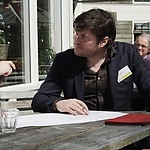Last sunday, VPRO Tegenlicht broadcasted the episode ‘End of ownership’, in which the Dutch architect Thomas Rau advocates the creation of a closed sub-system for the materials our society uses in products. Since the planet is a closed system, we need to reuse materials to allow the human species to continue living with a comparable level of prosperity and comfort.
One of the approaches for regaining materials is to lease products instead of selling them. This way, the company holds ownership over the product and thus controls the product during its lifetime and at its end-of-life. The customer uses the product at home (or in the office) for a specified period of time, while paying a monthly fee. After use, the company takes back the product, gives it a second life or recycles it.
Expensive sustainable products won’t become mainstream
Rau stresses the advantages of ‘end of ownership’ for the planet, but only quickly mentions the business perspective. Forgetting about the financial aspect of sustainability gives skeptical watchers the opportunity to believe that Rau’s ideas cost money, ‘just like all other sustainable initiatives’. I believe that
more expensive sustainable products will never become mainstream products.
Sustainable products which are more expensive than the non-sustainable variant might flourish in a niche of idealistic consumers, but this market will not grow sufficiently to create a healthy business. Numerous studies have proven that citizens are generally concerned with the environment and approve of sustainable product options. However, in the role of consumer (standing in the supermarket), they act according to their personal gain and choose the cheaper non-sustainable product. I don’t believe the average consumer will want to pay for sustainability.
This notion does not mean sustainable products are hopeless. On the contrary, they can be very promising, but only in case the product is financially attractive for both the producer and customer. This is certainly possible, but requires companies to review their way of doing business. Specifically, they need to revise their business models by thinking about new ways of offering the product to their customers, while generating income in new ways.
A sustainable product with an attractive business model
As an example of a sustainable business model, Rau discusses the lease construction of an energy efficient refrigerator. This is a good example of a financially attractive sustainable product.
The user leases the product for a low price per month. the investment of the fridge would have been way to high, so the user would have compromised with a cheaper version. However, cheaper fridges generally use more electricity which raises their monthly costs. Thus, taking the whole lifetime of the fridge into consideration, the energy efficient lease fridge is cheaper to use.
During this leasing period, the producer is in total control of the fridge, performing maintenance and repair when needed. Once the first user stops his contract the producer has the option to remanufacture the fridge, including revision and maybe even replacement of broken or worn out parts, before passing the fridge to the second. When the fridge breaks down, the producer knows how to recycle it and reuse the materials. All mentioned actions are cost reducing, because the producer needs less virgin materials and less production of new parts or products, while offering the same service to the user.
New business models
This example clearly shows the financial attractiveness for both the producer and the user, especially on the long term. The advantages for the planet are obvious, since all materials are collected by the producer and it is in his advantage to reuse them as efficiently as possible.
The illusion that sustainable products are more expensive has been proven untrue. Admitted, it can be challenging for companies to find new business models which are attractive from both the financial and environmental perspective, but they do exist! It requires a new way of thinking about business and seeing opportunities.
Currently, the ministry of Infrastructure and Environment subsidizes a project in which companies are supported in this phase of discovering sustainable business models: CIRCO creating business through design. Are you interested in sustainable products, but skeptical about their financial attractiveness? Joining the CIRCO Circular Business Design Track will open your eyes to identify financially attractive and sustainable business opportunities.
